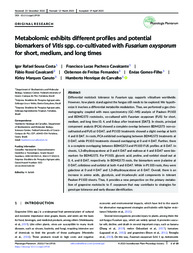Metabolomic exhibits different profiles and potential biomarkers of Vitis spp. co-cultivated with Fusarium oxysporum for short, medium, and long times.
Metabolomic exhibits different profiles and potential biomarkers of Vitis spp. co-cultivated with Fusarium oxysporum for short, medium, and long times.
Author(s): COSTA, I. R. S. C.; CAVALCANTE, F. L. P.; CAVALCANTI, F. R.; FERNANDES, C. de F.; GOMES-FILHO, E.; CANUTO, K. M.; CARVALHO, H. H. DE
Summary: Differential rootstock tolerance to Fusarium spp. supports viticulture worldwide. However, how plants stand against the fungus still needs to be explored. We hypothesize it involves a differential metabolite modulation. Thus, we performed a gas chromatography coupled with mass spectrometry (GC?MS) analysis of Paulsen P1103 and BDMG573 rootstocks, co-cultured with Fusarium oxysporum (FUS) for short, medium, and long time (0, 4, and 8 days after treatment [DAT]). In shoots, principal component analysis (PCA) showed a complete overlap between BDMG573 non-cocultivated and FUS at 0 DAT, and P1103 treatments showed a slight overlap at both 4 and 8 DAT. In roots, PCA exhibited overlapping between BDMG573 treatments at 0 DAT, while P1103 treatments showed overlapping at 0 and 4 DAT. Further, there is a complete overlapping between BDMG573 and P1103 FUS profiles at 8 DAT. In shoots, 1,3-dihydroxyacetone at 0 and 4 DAT and maltose at 4 and 8 DAT were biomarkers for BDMG573. For P1103, glyceric acid, proline, and sorbitol stood out at 0, 4, and 8 DAT, respectively. In BDMG573 roots, the biomarkers were β-alanine at 0 DAT, cellobiose and sorbitol at both 4 and 8 DAT. While in P1103 roots, they were galactose at 0 and 4 DAT and 1,3-dihydroxyacetone at 8 DAT. Overall, there is an increase in amino acids, glycolysis, and tricarboxylic acid components in tolerant Paulsen P1103 shoots. Thus, it provides a new perspective on the primary metabolism of grapevine rootstocks to F. oxysporum that may contribute to strategies for genotype tolerance and early disease identification.
Publication year: 2023
Types of publication: Journal article
Unit: Embrapa Grape & Wine
Keywords: Fusarium, Fusarium Oxysporum, Fusarium spp, Paulsen BDMG573, Paulsen P1103
Observation
Some of Embrapa's publications are published as ePub files. To read them, use or download one of the following free software options to your computer or mobile device. Android: Google Play Books; IOS: iBooks; Windows and Linux: Calibre.
Access other publications
Access the Agricultural Research Database (BDPA) to consult Embrapa's full library collection and records.
Visit Embrapa Bookstore to purchase books and other publications sold by Embrapa.

